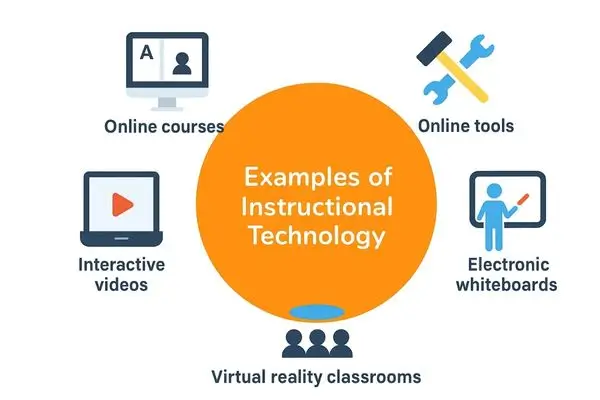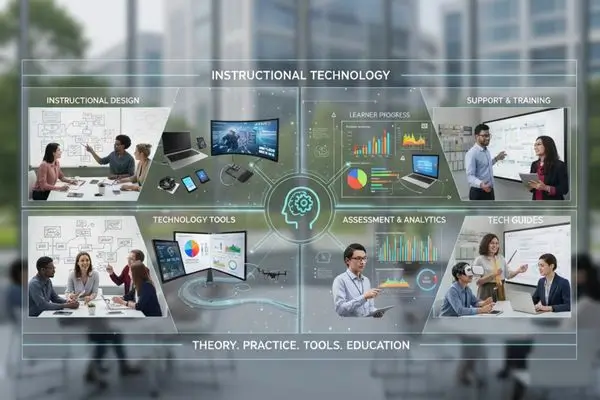Instructional Technology Services (often referred to as EdTech or learning-tech services) provide specialized support and solutions that help educators, trainers, and organizations utilize technology to design, deliver, and enhance learning experiences.
Topics
Table of Contents
In short, it serves as the bridge between education/training and technology tools.
These services include:
- Integrating learning management systems (LMS)
- Creating digital content (videos, interactive modules)
- Training teachers or trainers in using tech tools
- Providing technical support for hardware/software in educational settings
- Advising on pedagogy + technology alignment
- Monitoring effectiveness and using analytics to adapt
What Is Instructional Technology?
Instructional technology (or instructional Design + technology) refers to the theory, practice, and tools used to support education through technology. It involves:
- Instructional Design (how to structure learning)
- Technology tools (platforms, hardware, software)
- Assessment & analytics (tracking learner progress)
- Support & training (helping educators & learners use the tech)
So, it is not just about gadgets — it is about how to use them to improve learning outcomes.
What Is an Example of Instructional Technology?
Here are real-world examples:
- A school uses Moodle or Canvas as an LMS to deliver courses online or in blended form.
- Teachers use interactive whiteboards, clickers, or smart boards to make lessons dynamic.
- Organizations use eLearning authoring tools like Adobe Captivate or Articulate Storyline. University of San Diego Online Degrees
- Use of interactive videos, simulations, or virtual/augmented reality for immersive learning.
- Tools like polling apps, quizzes, and collaboration platforms (e.g., Aha Slides) are integrated into lessons.
- In higher education, faculty use Google Forms, discussion forums, screencasting, and Wikis as part of their tech-enhanced teaching.
5 Basic Concepts of Instructional Technology?
While frameworks differ, commonly the five key concepts include:
- Instructional Design — planning how learning experiences are structured
- Learning Theory — understanding how people learn (cognitive, behaviorism, constructivism)
- Media & Tools — selecting and using the appropriate tech (software, hardware)
- Evaluation & Assessment — measuring effectiveness and learning outcomes
- Professional Development & Support — training educators and maintaining the infrastructure
These are foundational ideas that guide the delivery of instructional technology services.

What Is the Role of an Instructional Technology Specialist?
An Instructional Technology Specialist (also referred to as an Educational Technology Specialist) acts as a connector, helping teachers, trainers, and organizations adopt and utilize instructional technologies with purpose, rather than merely for gadget use.
Key responsibilities include:
- Collaborating with teachers to integrate tech into the curriculum
- Training educators on instructional tools and best practices NSTA+1
- Evaluating and selecting software/hardware suited to learning goals
- Troubleshooting & supporting tech in classrooms or training environments NSTA+1
- Monitoring and assessing how well tech tools are working
- Staying current with new technologies and pedagogical trends
They need both educational insight and technical skills to make tech adoption effective, not just flashy.
Instructional Technology Services Examples
Here are examples of services that institutions or companies might offer under the umbrella of instructional technology:
- Tech integration consultation: auditing current tools and proposing upgrades
- Custom content development: building e-learning modules, videos, microlearning
- LMS management & support: setup, user management, plugin integrations
- Training & professional development: workshops for faculty, staff, or corporate trainers
- Help desk / technical support: solving day-to-day issues (software bugs, hardware malfunctions)
- Analytics & reporting: gathering data on learner progress, usage, and outcomes
- Accessibility services: ensuring all learning materials are accessible (for disabilities)
- Blended/hybrid learning design: combining in-person and online strategies
Instructional Technology Services in Education
In K–12, higher education, or other learning institutions, instructional technology services are often embedded in:
- Teaching & Learning Centers that support faculty
- Educational technology departments that manage LMS & tools
- Distance learning units for online education
- Instructional design teams working on course redesigns
- IT/EdTech teams working alongside academic staff
They ensure that technology enhances learning — not distracts from it.
Instructional Technology Tools
Here is a list of popular tools commonly used in instructional Design and tech-enabled learning:
CategoryTools / Examples
- LMS / Course platforms Moodle, Canvas, Blackboard, Google Classroom
- Authoring & eLearning design Adobe Captivate, Articulate Storyline, iSpring
- Interactive / engagement Kahoot!, Aha Slides, Nearpod, Poll Everywhere
- Video & media Edpuzzle, Camtasia, Screencast-O-Matic
- Assessment & quizzes: Google Forms, Quizizz, Socrative
- Collaboration/communication Zoom, Microsoft Teams, Slack, Padlet
- Simulation / VR / AR Virtual reality modules, augmented reality apps
- Analytics & dashboards: LMS analytics, custom dashboards
These tools, when used thoughtfully, can enrich learning experiences.
Electric Vehicles Demystified: The Ultimate easy Guide
Instructional Technology Services Courses & Programs
If someone wants to study this field, here are common academic and professional pathways:
- Degrees in Instructional Technology, Educational Technology, or Learning Sciences
- Specialist programs like Instructional Technology Specialist PK–12 certification eastern.edu
- Graduate degrees (Master’s / EdS) focusing on technology in education,
- Professional certifications (LMS certifications, eLearning authoring tool credentials)
- Short courses or microcredentials in instructional Design, gamification, blended learning

Instructional Technology Examples
Here are more detailed examples of how tech is used:
- Flipped classrooms: Students watch lectures at home and then complete exercises in class.
- Adaptive learning platforms: Software that adjusts difficulty based on student performance.
- Gamified learning modules: Using game elements (points, levels) to increase engagement.
- Virtual labs/simulations: For science, medicine, and engineering experiments online.
- Mobile learning (m-learning): Delivering lessons via smartphones/tablets.
- Social & collaborative tools: Wikis, discussion boards, peer assessments.
- Digital storytelling/multimedia: Students create videos, podcasts, and interactive narratives.
What Is Instructional Technology PDF?
A PDF resource on instructional technology typically covers definitions, theories, tools, case studies, best practices, and implementation steps. Many universities publish such PDFs as course reading materials.
If you need a ready-made PDF guide on instructional technology (free or paid), I can help you by compiling one for your site.
Instructional Technology Services Programs
Programs (in schools, universities, or organizations) offering instructional technology services might include:
- Center for Teaching & Learning / EdTech centers
- Professional development units for faculty
- Digital learning offices in colleges
- Corporate training & development units
- Instructional design teams contracted by schools or companies
These internal programs ensure that technology and pedagogy are aligned, sustainable, and supported.
Why Instructional Technology Services Matter
- Enhances learner engagement and motivation
- Makes education scalable and accessible
- Provides better feedback and analytics
- Supports differentiated learning; it is a blend of learning styles
- Bridges the gap between pedagogy and technology
Conclusion
Instructional Technology Services brings together technology, pedagogy, and Design to create meaningful learning experiences. Whether in schools, universities, or corporate settings, these services facilitate better learning, more efficient teaching, and a smarter use of tech tools, collectively leading to a more comprehensive approach.
Intro to Agentic AI: 7 Easy Steps to Understanding and Learning
Pingback: ChatGPT vs Grok 2025: Should You Cancel ChatGPT Plus?